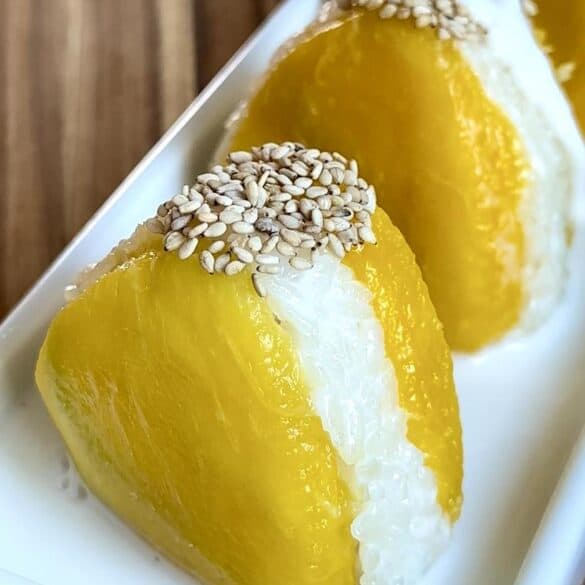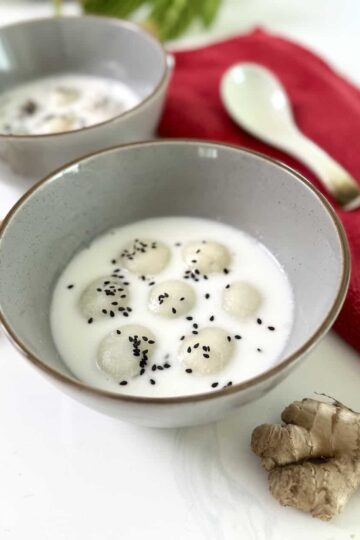Ready to take your taste buds on a trip to Thailand and Japan? Imagine juicy mangoes sandwiching sticky rice, all wrapped up in a luscious, dreamy coconut sauce. And if you're anything like me (seriously, I'm always hitting up my favorite Thai restaurant for this stuff), you know it's that combo of coconut goodness and sweet mango that keeps you coming back for more. Plus, for those like me who never tire of mango sticky rice, this inventive twist not only satisfies cravings but also allows for playful experimentation with texture profiles, visuals, and shapes, transforming it into an Ongiri. So why not grab one of these onigiri sandwiches and dive in? It's a flavor adventure you won't want to miss!
What is an Onigiri?
Onigiri is a Japanese food made of rice, shaped into a triangle, ball, or cylinder, and often wrapped in seaweed (nori). It usually has a filling inside, like pickled plum (umeboshi), salmon, or tuna with mayonnaise. It's a popular and convenient snack or meal in Japan. This versions uses classic Mango Sticky Rice and shapes them into a triangle for a fun twist!
Why you'll love this recipe
Mango sticky rice is a traditional Thai dessert that gets leveled up when you shape it into a rice ball (onigiri). The proportion of mango to sticky rice is absolute perfection. Plus, these can be easily shared with others!
Ingredients
- Glutinous Rice: Also known as sticky or sweet rice, it's the primary ingredient that gives the dish its distinctive texture. When cooked, glutinous rice becomes sticky and slightly chewy, providing a nice contrast to the smoothness of the mango and coconut milk.
- Unsweetened Coconut Milk: Coconut milk adds creaminess and richness to the dish. It's also essential for infusing the rice with a delightful coconut flavor, complementing the sweetness of the mango. Make sure to use the full-fat version for that extra creaminess.
- Sugar: Sugar is necessary to sweeten both the rice and the coconut milk mixture. It balances the natural tartness of the mango and enhances the overall sweetness of the dessert.
- Salt: Even though it might seem counterintuitive in a sweet dish, salt plays a vital role in balancing flavors. A pinch of salt can enhance the sweetness of the dessert while also highlighting the coconut and mango flavors.
- Toasted Sesame Seeds: While not traditionally included in all mango sticky rice recipes, toasted sesame seeds add a nutty flavor and a delightful crunch to the dish.
- Mango: The star of the dish, ripe mango adds natural sweetness, vibrant color, and a refreshing tropical flavor. Its juicy and slightly tangy taste pairs perfectly with the creamy coconut.
How to Make Mango Sticky Rice Onigiri
- Rinse the rice thoroughly in cold water until it's clear. Then, soak the rice in cold water, ensuring it's completely submerged, and let it soak overnight, for a minimum of 10 hours.
- Once soaked, drain the rice thoroughly using a sieve. Line a bamboo steamer with parchment paper and spread evenly on it. Fill a pot with water, ensuring there's at least a 2-inch gap between the water and the bottom of the steamer when placed on top.
- While the rice is cooking, in a small saucepan, bring 1 cup of coconut milk to a boil with ⅓ cup of sugar and a pinch of salt, stirring until the sugar dissolves completely. Remove from heat and keep the mixture warm.
- Transfer the cooked rice to a bowl and gently fold in the coconut-milk mixture. Cover the bowl and allow the rice to rest for 30 minutes, or until it absorbs the coconut milk. This can be prepared in advance, up to 2 hours ahead, and kept covered at room temperature.
- While the rice is resting, in a clean small saucepan, gently simmer the remaining ⅓ cup of coconut milk with the remaining 2 tablespoons of sugar, stirring occasionally, for about 1 minute. Transfer the sauce to a small bowl and refrigerate until it cools and thickens slightly.
- Cut the mango into shapes suitable for both the large and small onigiri molds.
- Assemble the mango sticky rice onigiri by placing a slice of mango into the mold, covering it with sticky rice, and adding another mango slice on top, allowing it to protrude slightly from the mold. Carefully press down and remove the mold.
- Arrange the mango sticky rice onigiri on a plate and serve alongside the chilled coconut sauce.
Storage
I recommend eating this as fresh as possible and within the same day.

Ingredients
1 ½ cups glutinous rice
1 ½ cups unsweetened coconut milk
¼ cup plus 2 tablespoons sugar
¼ teaspoon salt
1 tablespoon sesame seeds, toasted lightly
2 large mango, peeled, pitted, and cut into thin slices to fit a onigiri mold (if you don't have a mold, cut thin slices into small triangle)
Instructions
- Rinse the rice thoroughly in cold water until it's clear. Then, soak the rice in cold water, ensuring it's completely submerged, and let it soak overnight, for a minimum of 10 hours.
- Once soaked, drain the rice thoroughly using a sieve. Line a bamboo steamer with parchment paper and spread the rice evenly on it. Fill a pot with water, ensuring there's at least a 2-inch gap between the water and the bottom of the steamer when placed on top. Stream for 40-45 mins.
- While the rice is cooking, in a small saucepan, bring 1 cup of coconut milk to a boil with ⅓ cup of sugar and a pinch of salt, stirring until the sugar dissolves completely. Remove from heat and keep the mixture warm.
- Transfer the cooked rice to a bowl and gently fold in the coconut-milk mixture. Cover the bowl and allow the rice to rest for 30 minutes, or until it absorbs the coconut milk. This can be prepared in advance, up to 2 hours ahead, and kept covered at room temperature.
- While the rice is resting, in a clean small saucepan, gently simmer the remaining ⅓ cup of coconut milk with the remaining 2 tablespoons of sugar, stirring occasionally, for about 1 minute. Transfer the sauce to a small bowl and refrigerate until it cools and thickens slightly.
- Cut the mango into shapes suitable for both the large and small onigiri molds.
- Assemble the mango sticky rice onigiri by placing a slice of mango into the mold, covering it with sticky rice, and adding another mango slice on top, allowing it to protrude slightly from the mold. Carefully press down and remove the mold.
- Arrange the mango sticky rice onigiri on a plate and serve alongside the chilled coconut sauce.





Leave a Reply